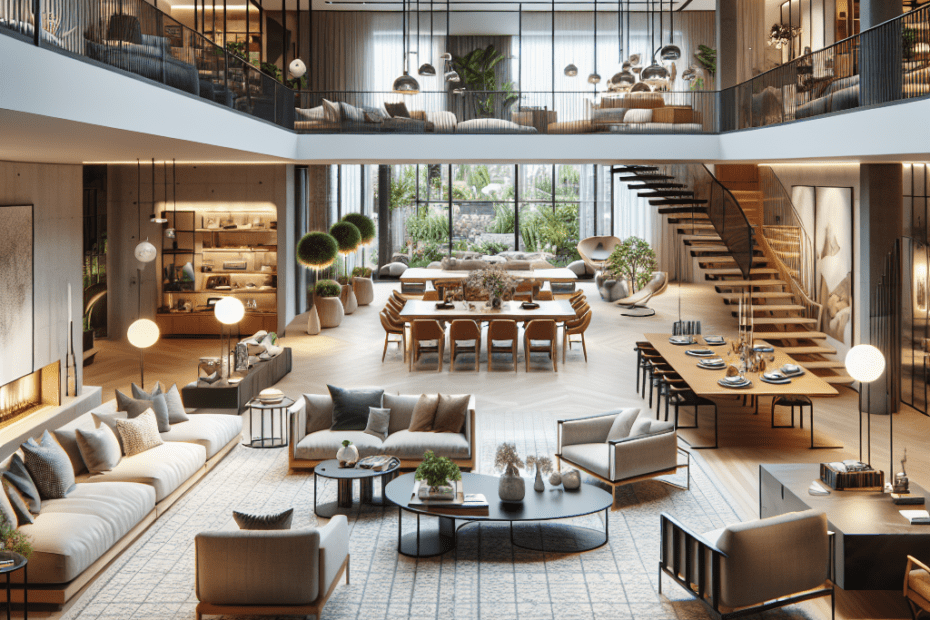“`html
Creating Defined Zones in Open Layouts
Open layouts are increasingly popular in modern home design, offering spacious and airy environments that encourage interaction and light flow. However, the challenge comes in arranging furniture to create distinct zones without constructing physical walls. Open layout zones can provide both aesthetic appeal and functional advantages, helping maximize the utility of every square inch.
Importance of Defined Zones in Open Layouts
The open layout provides a canvas where residents can express their creativity. But with the absence of walls, they face the challenge of distinguishing spaces for various activities. Defined zones enhance the usability of open layouts by clearly delineating areas for dining, relaxation, work, and play. Statistics from a survey by the National Association of Home Builders reveal that 54% of new home buyers prefer open layouts, showing the significant trend towards this design style.
Semantic Keywords
- Open layout zones
- Furniture arrangement
- Defined spaces in open designs
- Interior zoning techniques
- Room division in open layouts
Arranging Furniture for Functional Zones
To create successful open layout zones, homeowners can use furniture as invisible walls. Placing a sofa with its back to a dining area can subtly separate the living room, effectively zoning the space. Bookcases or shelves can act as both storage solutions and physical dividers without obstructing the open feel.
Experts advise keeping the following tips in mind when arranging furniture to define spaces:
- Use rugs to visually separate zones
- Choose furniture size and style according to the designated zone
- Consider pathways and flow between areas
Case Study: Open Layout Benefits
A study conducted by Zillow in 2022 found that homes with an effective open layout can sell for approximately $10,000 more compared to traditional layouts. This highlights the appeal and value of well-zoned open spaces. Clearly defined zones not only improve aesthetic organization but also support varied functional needs, such as having a cozy reading nook within a larger living area.
Key Takeaways
- Open layouts encourage interaction and light flow, but require careful furniture arrangement for defined zones.
- Furniture can act as invisible walls to create distinct functional areas.
- Rugs, furniture size, and style can contribute to clearly defined spaces.
- Open layout homes tend to have higher market value.
Table: Pros and Cons of Furniture Arrangement in Open Layout Zones
| Pros | Cons |
|---|---|
| Encourages natural light | May lack privacy |
| Flexible space usage | Requires careful planning |
| Increases home resale value | Possible noise issues |
| Promotes social interaction | Potentially higher heating/cooling costs |
Interior Design Techniques for Open Layout Zones
Designers can further enhance open layout zones using color palettes and lighting. Painting each zone a different color can be effective in delineating spaces while maintaining a cohesive look. Lighting fixtures like chandeliers or pendant lights can define dining areas, making them focal points within the open space.
Plants and artwork can also be powerful tools for without cluttering the room. Large potted plants can create natural separations, while a strategically placed piece of art can become the centerpiece that draws the eye and naturally designates an area.
FAQ Section
- What are open layout zones?
Open layout zones are areas within a large, open space that are functionally separated for different uses, such as a living area, dining area, or workspace. - How can you define zones without using walls?
Furniture such as sofas, rugs, and bookcases, can be strategically placed to visually and functionally divide a space into defined zones. - Why are open layouts popular?
Open layouts create a sense of spaciousness, allow for more natural light, and encourage social interaction, making them desirable in modern home design. - Are there downsides to open layouts?
Some downsides include lack of privacy, potential noise issues, and the need for careful planning to ensure functional space division. - How can lighting influence open layout zones?
Lighting can define a zone by highlighting a particular area, such as hanging a large pendant over a dining table, marking it as a distinct space within the open plan.
Open layouts, when effectively arranged, can improve not only the aesthetics and functionality of a home but also its market value. Carefully arranging furniture to establish open layout zones can result in a harmonious balance of openness and order, fulfilling both practical and design needs.
“`
